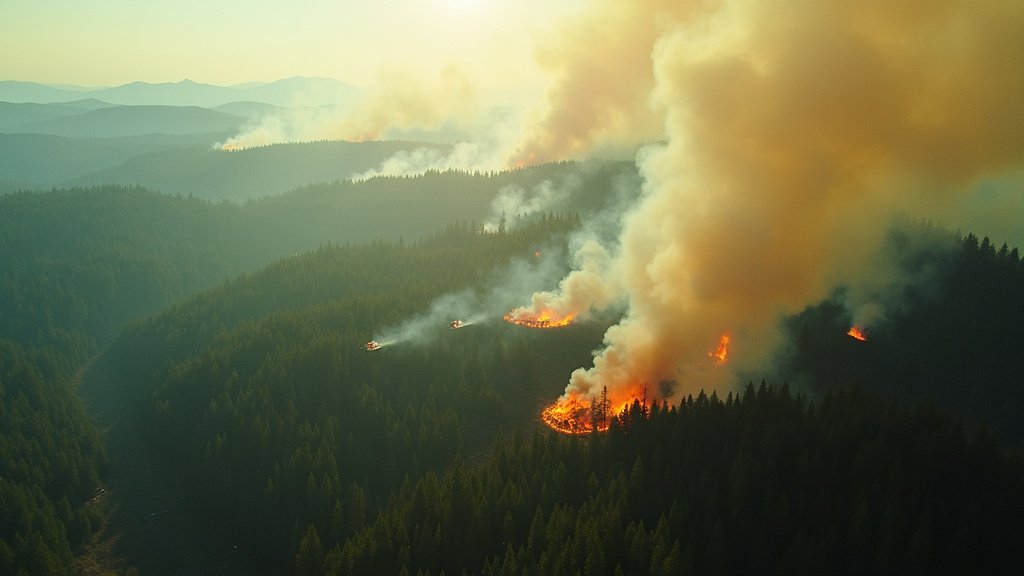Oregon’s 2025 Fire Season Concludes with Fewer Acres Burned Despite Increased Fire Starts
Oregon has officially closed its 2025 wildfire season, marking a period characterized by a higher number of fires but a significantly lower acreage burned compared to the preceding year. State forestry officials attributed this outcome to a combination of factors including aggressive initial attack strategies, rapid deployment of resources, dedicated firefighting efforts, and favorable weather conditions that shifted towards cooler, wetter patterns in the fall.
As of October 16, 2025, the Northwest Interagency Coordination Center (NWCC) reported that 2,569 fires had ignited across Oregon, burning approximately 288,774 acres. This figure represents a notable decrease from the devastating 2024 season, which saw around 1.9 million acres consumed by fire. While the total number of fire starts increased, with some sources indicating nearly 100 more starts on ODF-protected lands compared to 2024, the ability to contain these fires early prevented widespread destruction.
Aggressive Tactics and Dedicated Firefighters Key to Success
Oregon Department of Forestry (ODF) officials emphasized the critical role of their firefighters in managing the increased number of ignitions. Michael Curran, ODF Fire Protection Division Chief, noted that “94 percent of fires on ODF-protected lands were put out at 10 acres or fewer” in 2025. This statistic highlights the effectiveness of rapid response and containment efforts, meaning many potential large-scale fires were extinguished before they could significantly impact acreage.
Jessica Neujahr, an ODF spokeswoman, credited the dedication of the firefighting personnel, stating, “I would chalk it up to the dedication of our firefighters”. The proactive stance taken by ODF teams, informed by projections of potential fire danger similar to 2024, created a strong motivation to act swiftly on new ignitions. Governor Tina Kotek also invoked the Emergency Conflagration Act eight times, enabling the mobilization of essential firefighters and resources to combat blazes.
Favorable Weather Conditions Provide a Crucial Buffer
While forecasts had predicted a potentially catastrophic season mirroring 2024, a shift in weather patterns played a vital role in mitigating the severity of the 2025 fire season. Mid-season rains and the arrival of consistent fall weather, including cooler temperatures and shorter days, helped to dampen fuels and reduce fire risk across the state.
In the Southwest Oregon District, spokesperson Natalie Weber noted the absence of an early summer heatwave experienced in previous years, which contributed to slower fire growth. The widespread rain experienced across various districts allowed the Oregon Department of Forestry to officially declare the end of the fire season by mid-October.
Looking Back at the 2025 Season
The 2025 fire season saw a total of 1,135 fires on ODF-protected lands, burning 24,275 acres. Statewide, across all jurisdictions, the numbers rose to 2,569 fires burning 288,774 acres by October 16. For context, the historic 2024 season saw approximately 1.9 million acres burned.
Notable incidents during the 2025 season, despite the overall mild trend, included the Rowena Fire, which destroyed 56 homes near The Dalles, and the Burdoin Fire that followed shortly after, impacting numerous structures across the Columbia River. The Upper Applegate Fire also marked a significant event on June 18. A substantial lightning storm on July 7 ignited nearly 40 fires across Jackson and Josephine counties at once, creating challenging conditions for ODF firefighters.
End of Season and Future Preparedness
The official end of the fire season on October 17 meant that ODF-imposed fire restrictions were lifted for state-protected lands. However, state officials cautioned that local fire departments may still have specific regulations in place regarding debris burning or campfires, advising residents to check local ordinances.
As Oregon transitions into the fall and winter months, ODF districts are shifting their focus towards wildfire prevention, fuels reduction, and comprehensive mitigation planning for future seasons. The lessons learned from the 2025 season, particularly the success of aggressive initial attacks and the resilience of firefighting teams, will inform preparedness efforts for years to come.
The news from the 2025 fire season offers a positive outlook for Oregon, demonstrating that a combination of strategic management, dedicated personnel, and timely weather shifts can lead to a considerably less destructive outcome, even when faced with an increased number of fire starts. This news serves as a reminder of the ongoing importance of wildfire awareness and prevention.
Further reading: Related News on Google




